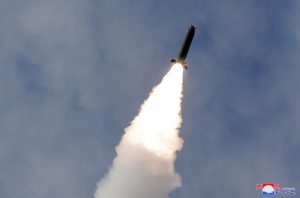On Monday, March 2, North Korean leader Kim Jong Un ordered yet another short-range ballistic missile test. The missile, fired near the town of Wonson on North Korea’s west coast, traveled 149 miles to the northeast before landing in waters off the Korean Peninsula. The launch was North Korea’s first missile test of 2020, coming a year after Pyongyang conducted over a dozen launches of various calibers.
There is an all too predictable pattern to these events. Pyongyang announces a missile test, only for Washington, Seoul, and Tokyo to condemn the launch as a violation of U.N. Security Council Resolutions (usually in the same boilerplate language) and stress that all three countries are vigilantly monitoring the situation. However, what the United States shouldn’t do is panic and overreact.
It’s tempting for any U.S. administration to hype the threat North Korea allegedly poses to the United States. Indeed, U.S. political and military officials have been quite effective at it; last January, Vice Chairman of the Joint Chiefs General John Hyten described North Korea as undergoing a missile bonanza of increasing range, lethality, and sophistication. In Hyten’s words, “North Korea has been building new missiles, new capabilities, new weapons as fast as anybody on the planet with the 115th most powerful economy in the world.” The North’s missile test this week, in addition to U.N. reports of Pyongyang enhancing its missile program in 2019 despite the strongest Security Council regime sanctions in history, would seem to support the general’s assessment.
Capability, however, doesn’t signal intent. There are many countries seeking to improve the quantity, quality, durability, and lethality of their weapons systems. Granted, Kim is more brutal than the typical head-of-state, but nothing in his near-decade in power suggests he is itching to deploy nuclear weapons and ballistic missiles in an offensive capacity.
How can we be so confident? It’s simple: Kim may be an enigma to those in the West, but he has actually demonstrated himself to be a clever figure who understands his country’s limits. He knows when to press his advantage at the negotiating table; when and how to send signals with the most impact to other world leaders; and how to prepare his people for a long road of difficulty ahead. Most importantly, Kim knows when to pull back. Washington doesn’t need to panic because there is no reason to panic; the United States isn’t dealing with a suicidal lunatic, but a human being who is as rational as any other dictator obsessed with his own reputation and power.
All of which is to say that Kim is as likely to send a nuclear-tipped ICBM to an American city as Xi Jinping, Emmanuel Macron, or Benjamin Netanyahu. The possibility of the North Korean leader waking up one morning on the wrong side of the bed and deciding to haphazardly order a nuclear attack on the United States is so minuscule that it’s not worth discussing.
Like all authoritarians, Kim’s top priorities are the longevity of the dynasty his grandfather and father built and the preservation of his place in that dynasty. Any decision that even exposes Kim to a challenge of his authority will be avoided for fear of losing the slightest control over the system. Needless to say, using a single one of the roughly 60 nuclear weapons Pyongyang possesses would create a series of events Kim wouldn’t dare contemplate: U.S. retaliation would result in nothing short of the incineration of his regime; the likely death of himself and his family; and the utter annihilation of North Korea as an independent, sovereign country. Kim’s fixation on his regime’s survival actually makes deterrence against the North easier for Washington to manage.
This doesn’t mean there aren’t circumstances when Pyongyang could envision leveraging its nuclear warheads. A situation in which Kim believed North Korea was under immediate military threat from the United States or its partners in East Asia could erupt into a scenario where the use of Pyongyang’s nuclear weapons becomes an option.
But this is all the more reason for Washington to maintain — and build upon — lines of communication with Pyongyang in order to exchange messages directly, reassure one another of their intentions, and decrease the prospects of a mishap quickly spiraling into an alarming conflict that could be as deadly as the 1950-1953 Korean War, which killed about 3 million people. Barring a much-needed change in the U.S. negotiating position, U.S.-North Korea nuclear talks are likely dead this year. A dialogue about strategic stability and crisis management, however, should become an active component of the U.S.-North Korea relationship regardless of how those nuclear negotiations proceed.
North Korea will continue testing missiles this year. The testing and production of nuclear weapons and ballistic missiles will continue as long as Washington fails to do the sensible thing and negotiate concrete arms control arrangements that cap the North’s stockpile and create a more stable and constructive bilateral relationship. Washington needs to keep a cool head: The United States has the power, ability, capacity, and will to deter North Korea indefinitely as it has ever since the country transformed into a nuclear state over 13 years ago.
Daniel R. DePetris is a fellow at Defense Priorities and a columnist at the Washington Examiner.

































